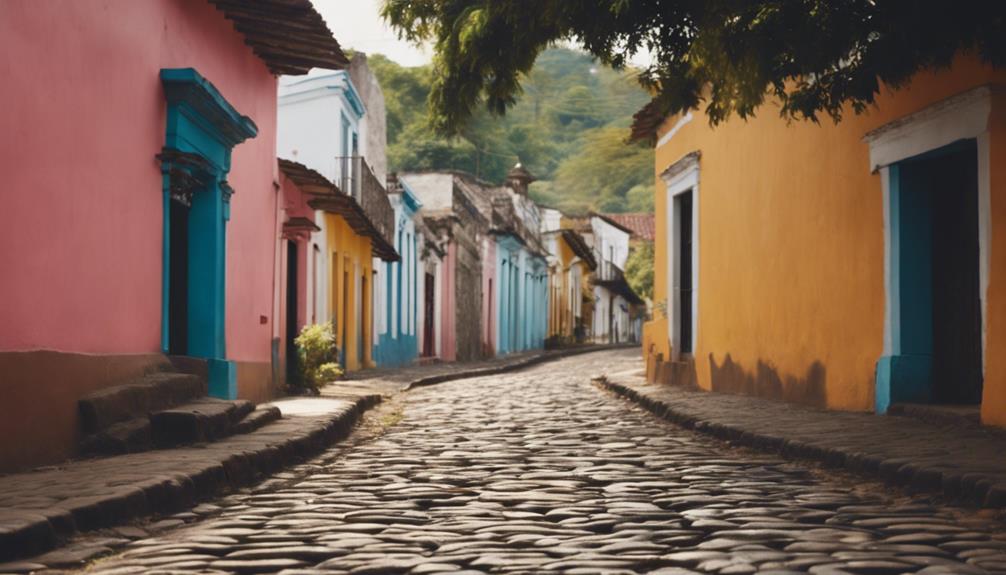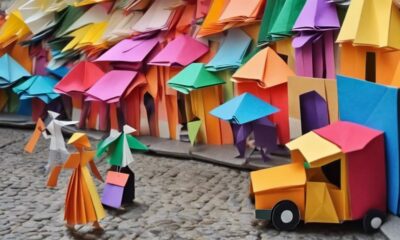El Salvador
El Salvador's Volcanic Landscapes and Colonial Cities
Capture the captivating charm of El Salvador's volcanic landscapes and colonial cities, where cultural fusion and natural wonders await exploration.

Experience El Salvador's enchanting blend of natural wonders and historical landmarks in its volcanic landscapes and colonial cities. With over 20 volcanoes shaping the terrain, iconic peaks like Izalco and Santa Ana offer panoramic views for adventure seekers. Explore historic 16th-century architecture in towns like Suchitoto, where Spanish colonial and indigenous influences create a unique fusion. Caldera lakes such as Coatepeque provide tranquility and aquatic adventures. Engage with Salvadoran heritage at local artisan markets, showcasing traditional crafts. Discover a rich tapestry of culture and beauty in El Salvador, where each corner holds a story waiting to be explored further.
Key Takeaways
- El Salvador boasts over 20 volcanoes, offering stunning views and adventure activities.
- Colonial towns like Suchitoto blend Spanish colonial architecture with indigenous influences.
- Volcanic landscapes provide natural beauty and geological history.
- Caldera lakes like Coatepeque offer tranquility and water-based fun.
- Cultural fusion in architecture and landscapes showcases El Salvador's rich heritage.
Overview of El Salvador's Attractions
Discover the diverse attractions of El Salvador, which include over 20 volcanoes, colonial cities, and UNESCO World Heritage sites. El Salvador's volcanic landscapes offer not only natural beauty but also a glimpse into the country's geological history. The panoramic views from these volcanoes provide a breathtaking experience, attracting visitors seeking adventure and stunning scenery. The iconic Izalco Volcano and the impressive Santa Ana Volcano are just a few examples of the majestic peaks you can explore in El Salvador.
Furthermore, the country's colonial cities, such as Suchitoto, are a treasure trove of cultural heritage. The well-preserved Spanish architecture and rich history of these cities transport you back in time, offering a unique blend of past and present. Immerse yourself in the vibrant atmosphere of Suchitoto and other colonial towns, where every cobblestone street tells a story of El Salvador's colonial past.
Don't miss the opportunity to witness this harmonious mix of natural wonders and cultural richness in El Salvador.
Exploring Colonial Towns

When exploring colonial towns in El Salvador like Suchitoto and Panchimalco, you'll encounter historic architecture that dates back to the 16th century, showcasing a blend of Spanish colonial and indigenous influences.
The preservation of cultural heritage is evident in landmarks such as Santa Lucía Church and San Sebastián Church, where native and colonial design elements intertwine seamlessly.
Additionally, you can immerse yourself in the vibrant local artisan markets, where traditional crafts and artwork reflect the rich cultural tapestry of these charming towns.
Historic Architecture Charm
Immersing yourself in El Salvador's colonial towns reveals a fascinating blend of Spanish colonial architecture and indigenous influences from the 16th century. Places like Suchitoto and Panchimalco showcase the charm and historic architecture of this era, where buildings reflect a fusion of native roots and colonial design elements.
Landmarks such as the Santa Lucía Church and San Sebastián Church stand as demonstrations of this unique blend, with intricate details that highlight the cultural richness of these towns. The vibrant festivals and local artistry add to the allure of these colonial towns, offering visitors a glimpse into the past and the enduring influence of Spanish colonial architecture.
Exploring the cobblestone streets and centuries-old buildings provides a tangible link to El Salvador's history, inviting you to appreciate the intricate beauty and architectural heritage that define these colonial gems.
Cultural Heritage Preservation
Exploring the colonial towns of El Salvador reveals a rich tapestry of Spanish colonial design intertwined with indigenous influences from the 16th century. These towns, such as Suchitoto and Panchimalco, stand as affirmations to cultural heritage preservation, blending traditional architecture with a vibrant cultural heritage.
Landmarks like Santa Lucía Church and San Sebastián Church exemplify the fusion of native and colonial design, showcasing the intricate balance between Spanish colonial influences and indigenous roots.
In these colonial towns, festivals and artistry flourish, offering visitors a glimpse into El Salvador's rich cultural history. The preservation of traditional architecture and customs in these towns not only serves as a connection to the past but also contributes to the unique charm and character of El Salvador's cultural landscape.
Local Artisan Markets
In colonial towns like Ataco and Suchitoto, you can discover a vibrant array of local artisan markets showcasing traditional Salvadoran crafts and artistry. These artisan markets offer a glimpse into the rich cultural heritage of El Salvador, with handmade crafts, textiles, and pottery that are unique to the region.
As you meander through the stalls, you'll encounter intricate wood carvings, colorful textiles, and indigenous-inspired jewelry that highlight the skill and creativity of local artisans. Immersing yourself in these markets allows you to support the talented individuals behind these creations and take home one-of-a-kind souvenirs that capture the essence of Salvadoran craftsmanship.
The handicrafts found in these markets not only serve as beautiful mementos but also reflect the deep-rooted history and traditions of the colonial towns. By exploring these local artisan markets, you have the opportunity to engage with the cultural fabric of El Salvador and gain a deeper appreciation for the artistry that defines these communities.
Unveiling Volcanic Landscapes

With 23 volcanoes shaping its landscape, El Salvador offers a unique opportunity to witness the raw power of nature. The country's volcanic landscapes, including the iconic Izalco Volcano, known as the 'Lighthouse of the Pacific,' showcase the dynamic geological history of the region.
Cerro Verde National Park beckons visitors with eco-trails that wind through lush forests, offering stunning views of the surrounding volcanoes like the Santa Ana Volcano, the highest peak in El Salvador.
Hiking the Santa Ana Volcano provides a panoramic vista of the Coatepeque Caldera, a massive crater lake formed by ancient volcanic activity. The San Salvador Volcano, located near the capital city, is another prominent feature of the country's volcanic scenery, attracting nature enthusiasts, hikers, and photographers alike.
These volcanic landscapes not only offer adventure but also serve as a reminder of the raw beauty and power found in El Salvador's natural environment.
Cultural Fusion in Architecture

Amidst El Salvador's volcanic landscapes, the architectural fusion of Spanish and indigenous design elements emerges as a vibrant expression of the rich cultural history of the region.
The colonial architecture in El Salvador showcases a unique blend of European and Mesoamerican influences, creating a distinct style that reflects the historical and cultural heritage of the area.
Some key features of this cultural fusion in architecture include:
- Intricate details like colorful facades and ornate balconies that adorn many colonial buildings.
- The blending of European and Mesoamerican cultures is evident in the architectural motifs and designs.
- Spanish colonial influences such as courtyards, arcades, and religious symbols are prevalent in the structures.
These colonial buildings serve as a tangible link to the past, offering a glimpse into the complex history of El Salvador and the merging of Spanish and indigenous architectural traditions.
Adventuring Through Caldera Lakes

Discover the allure of El Salvador's caldera lakes, offering a blend of tranquility and adventure amidst their volcanic origins. Formed by ancient volcanic eruptions, caldera lakes like Lake Coatepeque and Lake Ilopango hold historical significance dating back centuries.
Lake Ilopango, originating from a significant eruption 1,500 years ago, serves as a reminder of the country's tumultuous geological past. These caldera lakes provide not only serene escapes but also opportunities for aquatic adventures and recreational activities.
Once considered sacred sites by ancient civilizations, these lakes now attract visitors with their natural beauty and opportunities for water-based fun. Whether it's kayaking on the crystal-clear waters, fishing for local species, or simply enjoying a leisurely boat ride, the caldera lakes of El Salvador offer a diverse range of experiences for nature enthusiasts and adventure seekers alike.
Immerse yourself in the breathtaking landscapes and rich history surrounding these stunning bodies of water.
Heritage and Natural Wonders

El Salvador's heritage and natural wonders offer a compelling blend of historical colonial architecture and breathtaking volcanic landscapes.
The well-preserved Spanish colonial cities, like Suchitoto and Santa Ana, provide a glimpse into the country's rich cultural heritage.
Meanwhile, the over 20 volcanoes scattered across the landscape offer not only stunning views but also unique hiking opportunities for adventurous visitors.
Historical Colonial Architecture
Explore El Salvador's historical colonial architecture, a blend of Spanish influence and indigenous roots dating back to the 16th century.
The colonial cities of Suchitoto and Panchimalco showcase a unique fusion of European colonial design with native traditions, creating a mesmerizing architectural landscape.
Santa Lucía Church and San Sebastián Church stand as prime examples of this cultural amalgamation, where intricate details and structural elements reflect the meeting of two distinct worlds.
The colonial towns in El Salvador not only serve as historical landmarks but also as vibrant hubs for festivals that celebrate the diverse cultural heritage of the region.
Walking through the cobblestone streets and admiring the colonial architecture of these towns offers a glimpse into the country's rich history, where each building tells a story of resilience and cultural exchange.
Immerse yourself in the beauty of El Salvador's colonial architecture, where the past comes alive in the intricate facades and timeless charm of these historical gems.
Breathtaking Volcanic Landscapes
Immerse yourself in El Salvador's awe-inspiring volcanic landscapes, a tribute to the country's rich heritage and natural wonders. With over 20 volcanic formations, El Salvador showcases a diverse and unique volcanic landscape that captivates visitors with its stunning views and lush vegetation. The Izalco Volcano, often referred to as the 'Lighthouse of the Pacific,' stands as one of the most iconic and historically active volcanoes in the country, adding to the allure of the volcanic landscapes.
Adventurers can explore the eco-trails near the Cerro Verde Volcano, offering panoramic vistas of surrounding volcanoes and an abundance of greenery. These volcanic landscapes not only provide a playground for adventure activities such as hiking, climbing, and ash sliding but also hold significant cultural and geological importance in shaping El Salvador's heritage. They contribute not only to the country's natural beauty but also offer a glimpse into its rich cultural past, making them a must-visit for those seeking both thrills and historical insights.
Frequently Asked Questions
What Is the Colonial City in El Salvador?
In El Salvador, the colonial city you seek is Suchitoto. This charming city boasts well-preserved Spanish colonial architecture from the 16th century. Suchitoto's cobblestone streets, white-washed buildings, and historic churches offer a glimpse into the country's colonial past.
Cultural events, art galleries, and museums celebrate Suchitoto's heritage. Landmarks like Santa Lucía Church and San Sebastián Church showcase a blend of native and colonial architectural styles. It's a must-visit for history, culture, and natural beauty enthusiasts.
How Did Colonization Affect the Culture of El Salvador?
When discussing how colonization affected the culture of El Salvador, it's important to understand the profound impact of Spanish influence.
One notable aspect is the introduction of Catholicism, which became a dominant religion shaping societal norms and practices.
Spanish language imposition also played a pivotal role in altering the linguistic landscape of the region.
The blending of Spanish and indigenous cultures led to a unique Salvadoran identity, marked by a fusion of traditions and customs.
What Kind of Landscape Does El Salvador Have?
El Salvador boasts a diverse landscape, featuring towering volcanoes, lush forests, and fertile farmlands. With over 20 volcanoes, some still active, the country's terrain has been shaped by volcanic activity. This has resulted in stunning crater lakes and fertile volcanic soil, ideal for agriculture.
The volcanic landscapes also offer opportunities for adventure activities like hiking, volcano climbing, and exploring lava fields. Colonial cities nestled within this terrain provide a mix of history, culture, and natural beauty for exploration.
What Was El Salvador Like Before Colonization?
Before colonization, El Salvador was home to various indigenous groups like the Pipil, Lenca, and Ch'orti'. These communities thrived through agriculture, intricate structures, and well-developed social systems. Each group had distinct languages, religious beliefs, and cultural practices that defined their existence.
However, the arrival of Spanish colonizers in the early 16th century brought significant changes, introducing European culture and altering the political, economic, and social landscapes of the region.
Conclusion
To sum up, El Salvador offers a unique blend of colonial charm and breathtaking volcanic landscapes that are sure to captivate any traveler. With over 20 volcanoes dotting the landscape, the country boasts one of the highest concentrations of volcanoes in Central America.
Whether exploring historic towns, admiring cultural architecture, or hiking around caldera lakes, El Salvador's diverse attractions offer a rich tapestry of experiences waiting to be discovered. Plan your next adventure to this hidden gem and uncover the beauty of El Salvador.

-

 Texas2 months ago
Texas2 months agoWaco's Historic Sites and Texas Comfort Food
-

 Michigan2 months ago
Michigan2 months agoStellantis Leadership Team: Guiding Global Auto Giants
-

 Florida2 months ago
Florida2 months agoHistoric St. Augustine's Spanish Charms
-

 Alaska2 months ago
Alaska2 months agoThings to Do in Ketchikan Alaska
-

 Florida2 months ago
Florida2 months agoThings to Do in Panama City Florida
-

 Video Game2 months ago
Video Game2 months agoThings to Do in Minecraft
-

 Massachusetts2 months ago
Massachusetts2 months agoThings to Do in Boston With Kids
-

 Colombia2 months ago
Colombia2 months agoThings to Do in Cartagena


















